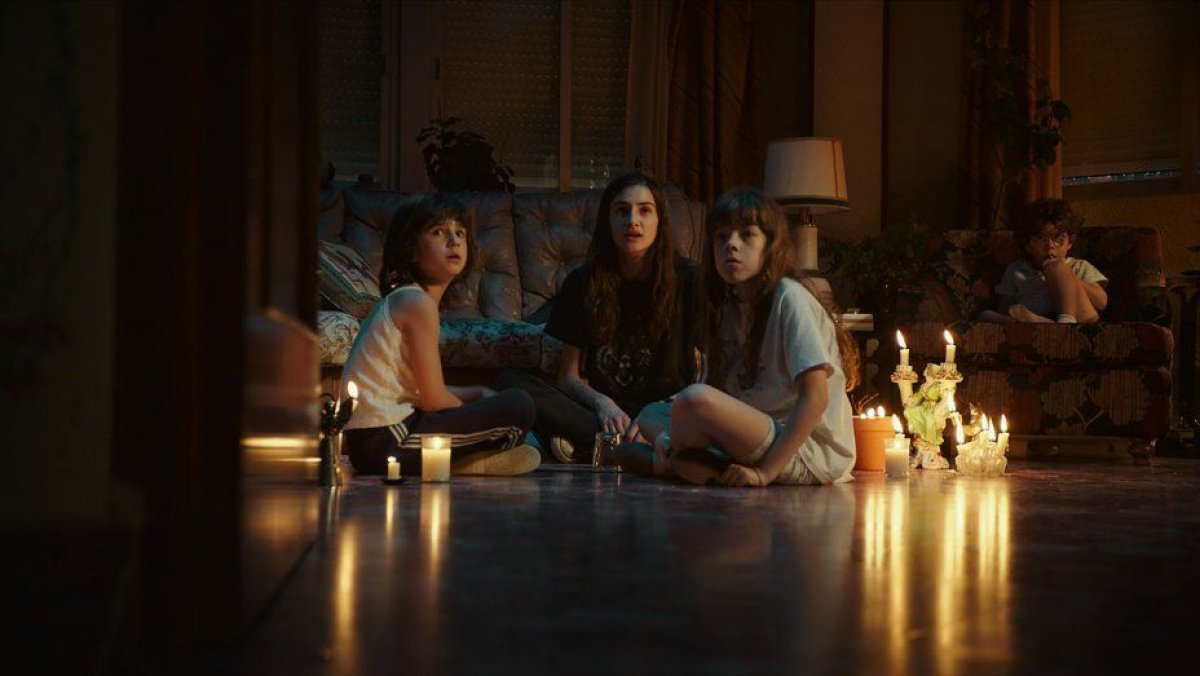Is Netflix's new horror movie based on actual events? We took a look at the original police report behind 'Veronica,' the scary new Spanish ghost movie.
Veronica, the new horror movie from Spanish director Paco Plaza (best known for 2007's zombie horror [REC] and its sequels) unceremoniously dropped on Netflix Monday, opens with an emergency call and ends with a police report. On-screen texts assert specific addresses, times, dates, even naming the police station in Madrid that took the call. Crime scene photographs accompany the credits. "This story is based on the police report filed by the detective in charge of the case," we read.
It's three days earlier than the emergency Veronica opens on—a typical school day. Veronica (Sandra Escacena) wakes up her younger twin sisters and younger brother to get them ready for school. Her mom works long, late hours at a nearby diner and sleeps in.
That day at school there's an eclipse and, piggybacking off the ritual power of the sun's occlusion, Veronica uses a Ouija board to reach out to her dead father. Unfortunately, something else comes through, something closer to a demon. It follows her home and drapes its long, lizard-like shadow over the children that have become her responsibility.
Fast-forward to three days later: "June 15, 1991, Detective Jose Ramon Romero went to the home on 8 Gerardo Nunez Street, in response to an emergency call…"
That's the movie version. What's the true story behind Veronica?
Is Veronica True? The Real Parts Of Netflix's New Scary Movie
The police report is real. Scans are available online, with a glut of write-ups around the 20th anniversary of what came to be known as the "Vallecas Case" by Spanish-language paranormal sites. The case takes its name from the Madrid neighborhood where a young woman, Estefania Gutierrez Lazaro rather than Veronica, reportedly performed a seance at school. A nun broke her Ouija board, ending or interrupting the ritual. She later experienced months of seizures and hallucinations, particularly of shadows and presences surrounding her.
And just like at the end of Veronica…
Estefania died, but not at home battling a demon. Instead, she died in a Madrid hospital in August 1991. But the police report doesn't really have much to do with her. Though the details of her possession—including more lurid, unverifiable claims, like that she inhaled a paranormal vapor from the shattered pieces of the glass Ouija planchette—are widely asserted, Estefania's family didn't get the police involved until more than a year after her death. Though later ghost encounters would receive the imprimatur of multiple witnesses and the police, the actual basis for the plot of Veronica is little more than an anecdote.
(And while we're mythbusting, no, Veronica is not the scariest movie ever made; it's not even the scariest movie Plaza has made.)
A year after her death, the police visited Estefania's family home and reported hearing a loud noise come from an empty porch, the door of a "perfectly closed armoire" opened "in a sudden and totally unnatural way," a crucified Jesus separated from his cross and a large, brown stain, attributed to drool. But though the facts of the case aren't quite as spectacular as the events in Veronica, the police report contains evocative descriptions, calling it a "situation of mystery and rarity." That they were witnessed by three officers and the Chief Inspect of the National Police, Jose Pedro Negri, goes a long way in explaining why the Vallecas Case continues to enjoy so much attention in Spain, including in television specials:
It's somewhat akin to the pop-culture durability of the Enfield Poltergeist in England or the Amityville Horror in the United States (both sites visited by ghost-hunting con artists Ed and Lorraine Warren), especially now that the Vallecas Case has a movie of its own.
During an audience Q&A at the Toronto International Film Festival, Plaza explained how he felt free to invent his own story and didn't really see it as in any way a documentary or accurate account.
"In Spain it's very popular, this story, because it is, as we say in the film, the only time a police officer has said he has witnessed something paranormal, and it's written in a report with an official police stamp and it's really impressive when you look at it," he said. "But I think when we tell something, it becomes a story, even if it's in the news. You only have to read the different newspapers to know how different reality is, depending on who's telling it. So I knew we were going to betray the real events. I just wanted to make a whole vision… but the whole story of Veronica and the sisters and Antonito, this little Marlon Brando with glasses, it's all a vision."

Veronica is now available to stream on Netflix.
Uncommon Knowledge
Newsweek is committed to challenging conventional wisdom and finding connections in the search for common ground.
Newsweek is committed to challenging conventional wisdom and finding connections in the search for common ground.
About the writer
To read how Newsweek uses AI as a newsroom tool, Click here.








